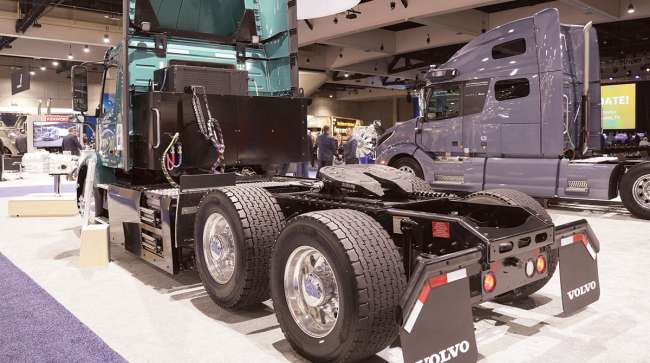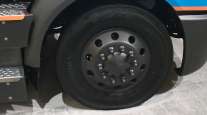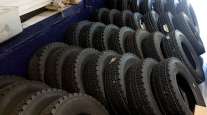Special to Transport Topics
Will Rise of Electric Trucks Bring Tire Design Changes?

[Stay on top of transportation news: Get TTNews in your inbox.]
The advent of electric-powered commercial trucks has raised new design considerations for vehicle components beyond the propulsion system — including tires.
Tire makers are examining potential reconfigurations for tires used on electric trucks to optimize performance, minimize wear and reduce the amount of time fleets spend reworking tried-and-true wear cycle metrics and replacement practices.
Weight and torque are the two main factors that affect electric trucks’ tire performance and wear. Electric motors provide greater, instantaneous torque, which affects rolling resistance. The torque is also different with EVs’ regenerative braking compared with hydraulic braking.
EV batteries add a significant amount of weight to the vehicle — up to 5,000 pounds, depending on battery type and range. Newer electric models are lighter than earlier ones, though.
“Intrinsic performances of the tires are put under tougher stresses by EVs, such as noise, vibration, wear,” said Jim Garrett, product category manager at Michelin North America.
Tire manufacturers are taking note of these operating differences and the impact on their products.

Host Michael Freeze relays the story of a cybersecurity crisis at a transportation and supply chain management company and discusses strategies to avoid cyberattacks with a 30-year veteran of automotive cybersecurity systems. Hear a snippet, above, and get the full program by going to RoadSigns.TTNews.com.
“We see a requirement to increase load capacity, and we see potential in terms of reducing rolling resistance,” said Helmut Keller, Continental’s head of product management for truck tires in the Americas. “But, and [this is] the tricky part, we cannot sacrifice mileage as we know it today.”
Same, but Different
Generally, Tier 1 tire brands do not currently offer specialty tires for Class 8 electric vehicles.
Instead, they are in a research-and-development phase for such products, or they’re investigating whether there is a need for entirely new products as EV designs evolve.
Those pursuing EV-friendly models are adapting their tires to remain about the same size while meeting higher load capacity demands. They’re investigating the best materials and construction to achieve the new goals.
Electric truck uptake is slower than for passenger vehicles, and heavy-duty truck adoption is slower than for light trucks. Therefore, tire manufacturers are extrapolating from their electric passenger and light truck tire data to influence decisions about heavy-duty truck tires.
“There are actually a fair number of similarities between the needs for a consumer EV tire and a commercial EV tire when we compare them to their [internal combustion engine] counterparts,” said David Reese, Goodyear’s vice president of product development for the Americas. “We do tend to see a little bit faster wear on consumer EV tires, and we can anticipate maybe some quicker wear on commercial.”

Reese
Goodyear is “actively developing new tires and new tire technologies” to mitigate these issues, he said. The company recently released the Endurance RSA ULT, one of its first tires for electric-drive commercial vehicles. It’s intended for urban or regional transport and has a higher load capacity, better durability and improved rolling resistance. Goodyear also released the UrbanMax MCA for electric buses, which has a stiffer, more robust tread.
“Those are our first entries into the market with specific tires that, quite honestly, are good for either ICE or EV, but they’re definitely designed with EV in mind,” Reese said.
Bridgestone recently released the R192E for electric buses. It has extra load capacity and improved rolling resistance. Bridgestone also is developing other products to address future EV needs, in addition to its existing line of passenger EV tires, said Robert Hamby, director of commercial product strategy at Bridgestone Americas.
Michelin similarly has a line of passenger EV tires. Absent a line for heavy-duty trucks, Garrett points to existing low-rolling-resistance tires to reduce the amount of energy required to propel a vehicle.

Hamby
“The emergence of Class 8 [battery-electric vehicles] seems to be gaining traction in the industry lately,” he said. “Michelin believes they will eventually be commonplace on roads, but the technology is not yet ready for use in many regional and longhaul trucking applications.”
Some manufacturers are hesitant to overhaul EV-specific tire designs until more concrete data emerges showing clear benefits over conventional tires.
“On the passenger side, you’ll see two trends: Some are already announcing that they have dedicated EV tires. But, it’s also not clear that those tires are anything special,” prompting some manufacturers to hold off with EV tire releases, Continental’s Keller said.
On the commercial vehicle side, “we need to see where the market is going before we go one way or the other.” Plus, “there are still no clear requirements from OEMs on this so far.”
Europe’s EV market is ahead of North America’s, largely to comply with environmental regulations, Keller said. He cited Europe’s more stringent emissions, range and rolling resistance requirements, along with a greater push to transition to EVs. Continental’s operations in the Americas are studying what’s happening in Europe for hints about what could come down the pike domestically, he said.
The California Air Resources Board has advanced plans to mandate a market shift toward zero-emission commercial trucks, which could thrust Class 8 electric truck development — and commercial EV tire development — into high gear.
Back to the Drawing Board?
Because tires exhibit different wear patterns on EVs compared with diesel-powered trucks, fleets might have to alter their knowledge of and metrics for traditional wear cycles. This can be controlled by paying attention to the proper settings and using the latest technologies, Bridgestone’s Hamby said.
Tread life and range should factor into fleet managers’ choices about whether to adopt EV tires and which ones to purchase, Goodyear’s Reese said. He also suggested that fleets consult with and use resources available from manufacturing partners to assess the market and different tires’ suitability for EVs.
Manufacturers promote retreading for tires used on EVs just like those used on diesels, perhaps to an even greater degree with electric trucks.
Electric trucks can “have a unique impact to a tire’s casing, meaning that retreading can become even more vital for the life of these tires,” Hamby said.
Experts generally doubted that fleets will have to scrap all the tire knowledge and practices they’ve accumulated over decades and start over with EVs.
Manufacturers’ research and development teams strive to meet changing industry needs with minimal impact to consumers.
“We’re all trying to think creatively and envision the future,” Reese said. “[EV tires] will be ready when the market needs them.”
Want more news? Listen to today's daily briefing below or go here for more info:




